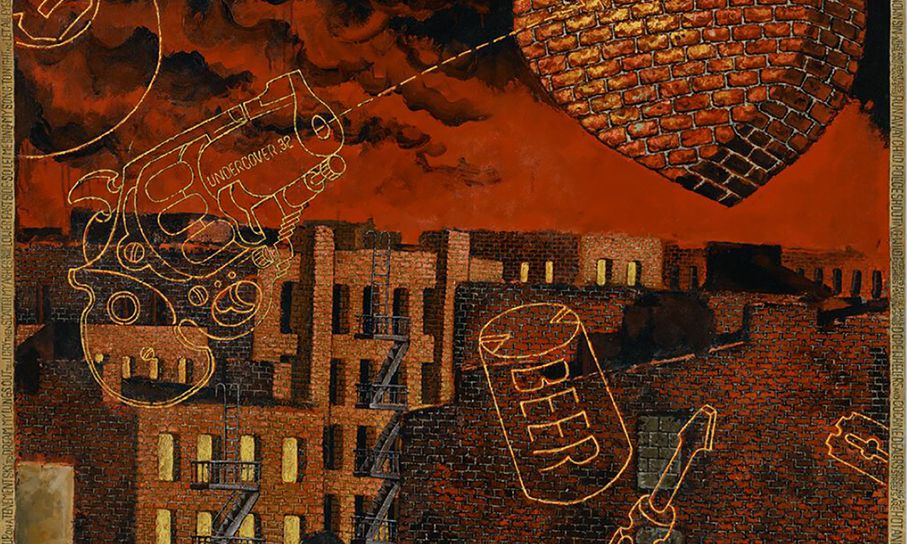Martin Wong’s Portrait of Mikey Piñero at Ridge Street and Stanton (1985)
Courtesy Christie’s
“The best painting by Martin Wong to ever come to auction” will be offered at Christie’s in New York this month, says Isabella Lauria, the house’s head of the 21st century evening sale. The late Chinese American artist’s market has been climbing rapidly for a decade, thanks in part to the longstanding efforts of the New York gallery PPOW, which represents his estate. A major travelling survey of Wong’s work in Europe, Malicious Mischief, most recently on show at the Stedelijk Museum in Amsterdam, has brought him to even greater attention, especially outside the US. Portrait of Mikey Piñero at Ridge Street and Stanton (1985) will likely break the artist’s auction record of $1.2m, made at Bonhams in New York in 2022.
This painting was executed in “Wong’s prime” and bears many of his signature motifs, Lauria says, including exposed brick, hearts and beer cans. It also carries an extremely personal story, depicting Wong’s lover, the playwright and actor Miguel (Mikey) Piñero, who was pivotal to introducing him to Manhattan’s creative and gay scenes, and is bordered by one of Piñero’s poems. Ten works by Wong depicting Piñero exist. This painting has only been owned by one person, the consignor, who bought it from Semaphore Gallery in New York in the 1980s. According to Christie’s, the collector, who is anonymous, was instructed by Wong how to specifically light the work so as to best bring out the metallic quality of the paint.
Lucio Fontana’s Concetto spaziale, La fine di Dio (1964)
Courtesy Sotheby’s
The Dallas collectors Howard and Cindy Rachofsky are selling a cadmium yellow work by Lucio Fontana at Sotheby’s New York that could fetch an auction record for the Italian post-war artist. Concetto spaziale, La fine di Dio (1964) is one of 38 works Fontana created in his coveted series of punctured canvases. It was acquired by the Rachofskys for a then record $2.3m in 2003, at a time when the Italian Arte Povera movement, with which Fontana was associated, had not yet achieved global recognition.
The couple had taken two trips to Switzerland in the late 1990s to view two other works in the Fine di Dio series, both pink, with a view to acquire one; both were priced around the $700,000 mark. However, an agreement on price could not be reached. Five years later, this picture came up. “We did not go to see this painting with the intention of falling in love with it. But in fact, we did. We thought this was as close to perfect as one could be,” Howard Rachofsky says. The acquisition “raised the bar” of their entire collection, he adds. All six of Fontana’s highest prices at auction have been achieved for comparable La Fine di Dio punctured works. The artist’s $29.1m auction record was made by Christie’s in New York in 2015 for another cadmium yellow work from this series.
John Olsen’s Eastern World (1971)
Courtesy Bonhams
John Olsen, who died in 2023, aged 95, was known in his final years as Australia’s greatest living painter, having been the last surviving member of a cohort who came to define the nation’s Modern art movement. From 1969 into the 1970s, Olsen worked on a number of tapestry designs—including this large, abstract woollen work—with the weavers Bruce Arthur and Deanna Conti, who were living on the remote Timana Island in Queensland. According to Bonhams, Olsen recalled that he first met the couple at the Rudy Komon Gallery in Sydney and subsequently made visits to the island with fellow artist Clifton Pugh.
Olsen’s tapestries such as Eastern World are very different in character to his earlier, more refined tapestries, which were made in Portugal, and are more exuberant in their densely textured surfaces, threading thick hanks and skeins of wool into and over the surface. On occasion they include strands of twigs and other natural materials. This work was exhibited in 1972 at the Art Gallery of South Australia, Adelaide. A related tapestry from 1971, Western World, is in the BHP Art Collection in Sydney.
Jean-Michel Basquiat’s Untitled (ELMAR) (1982)
Courtesy Phillips
This nearly 8ft-wide canvas comes from what is considered to be Basquiat’s most artistically successful year. The painting shows a “fallen angel” figure with a crown of thorns on the left, flanked by an archer releasing two arrows. It is one of three works by the artist being offered at Phillips this month from the collection of the late Italian anthropologist Francesco Pellizzi. He was the co-founder and editor of Res: Anthropology and Aesthetics, a journal published by the Peabody Museum at Harvard University and Chicago University Press. He bought the three works in the 1980s; this is the first time any of them will be offered publicly.

